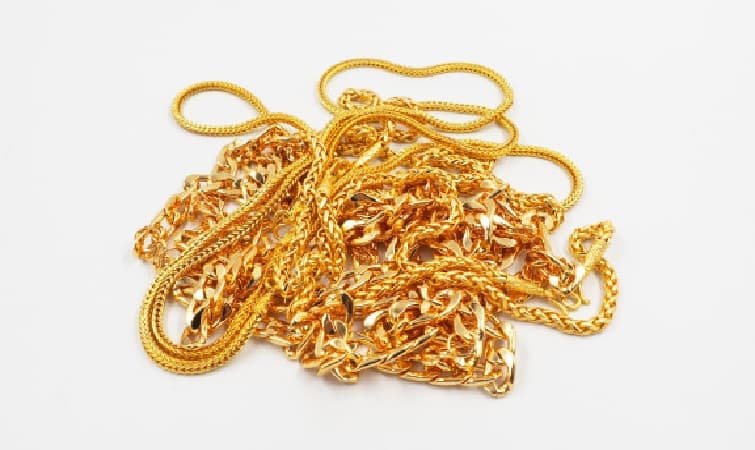Since ancient times gold has been a major component of Indian Culture, especially during festivals, pujas, engagements, marriages, and other celebrations.
This is evident in the female statues in temples and artwork dating back several centuries.
The figures were adorned with gold jewellery around their necks, hands, waist, and ankles.
Gold as a Social Status Symbol
In India, it is considered a status symbol in our society, and females (sometimes even males) flaunt their gold jewellery to show their standing in society. A person’s worth in society is directly proportional to the number of gold ornaments worn by the person.
Being part of the culture it is advisable to have some knowledge of this precious metal and how important it is to the growth of your family’s wealth. It is important to know the gold prices before buying or investing in any form of gold.
Purity of Gold
Pure gold has a 24 karat or fineness of 1000. In the case of 22 karats, the gold has 22 parts of pure gold and 2 parts of some other alloy – which is normally copper and has a fineness of 916.66. Gold jewellery is also made of 14K and 18K gold.
18K is composed of 75% which is alloyed with other metals to give it the strength to withstand daily wear and tear. Also, 14K gold comprises 58.3% gold and 41.7% is alloyed with other metals. The choice of the purity of the gold you want to purchase is entirely yours.
Different Colours of Gold
Gold can be identified by its colour. Basically, there are five colours of gold:
- Yellow Gold: This is the natural colour of gold with alloys. The alloys are usually copper which gives the gold its signature yellow colour.
- White Gold: White gold is made from a combination of metal alloys that are white in their natural state. It is plated with an extremely hard element called Rhodium. White gold tends to wear off easily over time. However, it can be re-plated and restored to its original state by a simple process.
- White Gold with Black Rhodium: In this case, black Rhodium is plated with white gold which gives it a royal black lustre. It is extremely hard and strong. Like white gold, this colour gold gets easily worn out. However, this too can be restored by a simple process.
- Rose Gold: This colour gold has a pink hue of a rose petal. It is created by mixing a copper alloy.
- Vermeil Gold: This gold has a rich golden colour which is extensively used for fine gold jewellery with intricate designs. It is also known as sterling silver.
Is it Legal to Charge for Wastages While Making Gold Jewellery?
According to the Government of India, Gold jewellery makers can ask for wastage charges. However, for studded jewellery, the jeweller cannot exceed 9% of the net weight. For none studded gold jewellery, wastage charges cannot exceed 3.5%.
In the case of coins, biscuits, and medallions the wastage charges cannot exceed 1.25%. Some jewellers do not charge for wastage but they do include it in the making charges.
Why do Gold Jewellery Shops Levy Making Charges?
The making charges include the cost of professional gold jewellery designers who conceptualise the design and the cost of the goldsmith who brings it to life. It
involves many hours of labour by master craftsmen who shape, polish, and mould the piece of gold jewellery to reflect the design given to them.
Pure gold is a soft metal and has to be reinforced with specific alloys to make it strong enough to produce intricate jewellery and withstand the rigours of daily life. Some jewellery pieces have gemstones used as part of the design. These stones need to be cut and shaped by skilled artisans who have to be paid. This adds to the cost of making.
Lastly, the making charge also depends on the intricacy of the jewellery piece. Intricate designs take a longer time to produce.
Why am I Charged for the Wastage?
The making process of a jewellery piece requires the melting of a gold bar and then shaping it according to the design given by the jewellery designer. In this process, a certain amount of gold gets ‘wasted’. Jewellers keep a margin to cover the cost of any gold that is wasted.
Jewellery made by using technology is generally more efficient and leads to a minimum amount of wastage while crafting the jewellery pieces.
Buying Jewellery without Being Cheated
There are several known brands like Tribhovandas Bhimji Zaveri, Tanishq, D’Damas, Nakshatra Diamond Jewellery, Gilli Jewellery, and many more. Buying at these branded stores will give you some assurance of the quality while the prices are fixed and on the higher side.
Buying from an unknown brand store is a bit tricky. They raise their gold prices to allow for bargaining with the customers. If you are good at bargaining you can probably strike a good deal with reduced making costs. The key is in your bargaining skills.
Follow us on social media to get personal finance tips: Facebook, Twitter and LinkedIn

